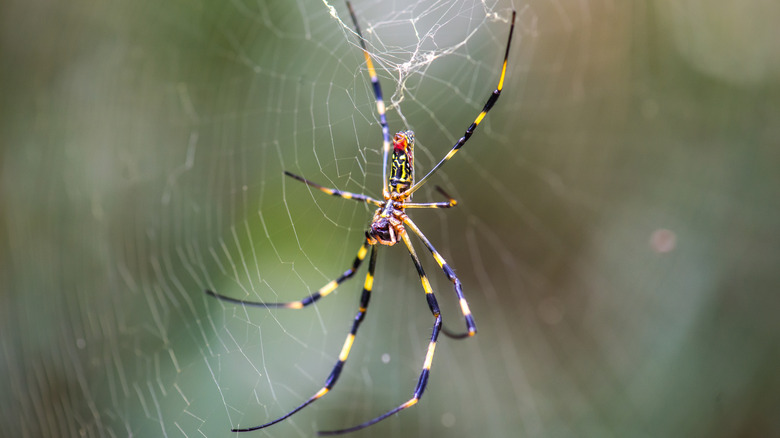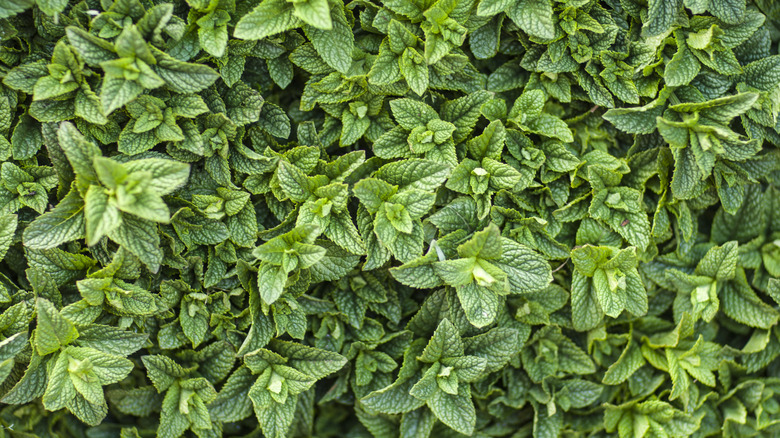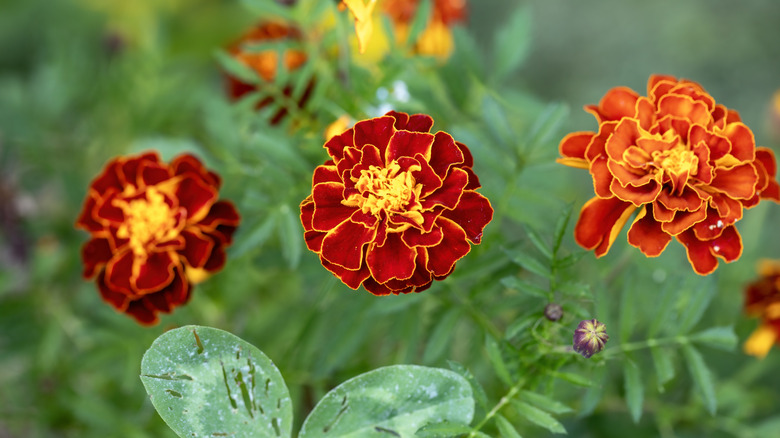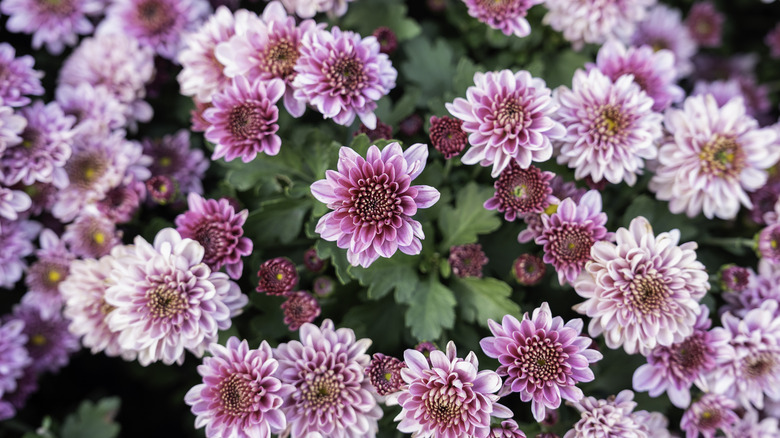Beautiful Plants That Double As Natural Spider-Repellents
As one of the most common pests, you're more likely to have a spider roommate at some point than not. Although many of these eight-legged creatures are harmless, not all spiders are created equal. Species like black widow and brown recluse spiders can deliver painful bites that cause an array of health issues for family members and pets. Even if you're dealing with non-venomous types, their webs in your home and garden can be frustrating.
The best way to get rid of spiders is to prevent them in the first place. Luckily, there are several beautiful plants that have arachnid-repelling power, making spiders less likely to invade your property.
Unlike chemical pesticides, natural options like aromatic herbs, flowers, and trees help the environment rather than hurt it. And while reaching for the spray may be tempting, it's important to know that these harsh chemicals won't just target the spiders; they can harm beneficial insects along with them. Strong-scented plants work well as a natural alternative because spiders smell and taste through their legs, making them less likely to walk on plants with an intense aroma. Whether you're a gardening aficionado or are new to the world of plants, this method can work for anyone, and many of the plants listed below grow well in planters, making it easy to incorporate them into your yard, no matter how big or small.
Mint
Mint (Mentha spp.) leaves not only make a delicious addition to certain foods and beverages, but they may also help with spider issues. Although there are several varieties of mint that will get the job done, peppermint (Mentha × piperita) seems to work the best. According to a study published by the Journal of Economic Entomology, peppermint essential oil strongly repelled two types of female spiders, suggesting they'd be less likely to build webs or lay their eggs in those areas. The running theory on why this herb effectively keeps spiders at bay is the strong menthol smell that mint plants emit. It's important to note that some mentha species, like spearmint, are sometimes considered invasive due to underground rhizomes, so opt for potted plants rather than adding them to a garden bed.
Most mint varieties are easy to grow and care for, making them perfect for beginners. To grow a mint plant, it's best to purchase young plants from a nursery or propagate cuttings from a friend, as seeds don't consistently sprout. Hardy in zones 5-9, choose a spot in your garden with rich soil that receives full to part shade. Peppermint loves regular watering and needs moist soil to thrive, so add mulch to the base to retain moisture. Your plant will grow up to 36 inches tall with up to 60-inch spread. When growing in your garden, it will not only repel spiders, but other pests like deer, rabbits, mice, and rats.
Lavender
Lavender (Lavendula angustifolia) is an herb famous for its clean and relaxing scent. Although humans enjoy using lavender-scented candles, soaps, and other products, spiders find it repulsive. This is mainly because lavender contains a large amount of linalool, a fragrant monoterpene compound regarded as a natural pesticide because of its adverse effects on a pest's nervous system. Even though lavender won't kill spiders, its strong scent will encourage them to head in another direction. Additionally, it helps repel other pests like ticks, fleas, and mosquitos, all while adding a soothing fragrance to your home or garden. However, if ingested, the linalool in lavender plants is toxic to pets, so it's best to keep it out of reach if you have dogs or cats.
If you want to kick spiders out of your house with lavender, you can plant it indoors near entry points or outside in containers or beds. This low-maintenance plant can thrive in poor to average soils, so there's no need to amend your soil or worry about fertilizing. That said, it likes well-drained, neutral to slightly alkaline soil. Once established, lavender is quite drought-tolerant, so you'll only need to water during extreme dry periods. In addition to its pest-deterring properties, lavender will attract beautiful pollinators, like butterflies and bees, when in bloom.
Citronella
For those who seem to have mosquito-attracting blood, citronella is likely already a trusted scent to keep the pests at bay. What you may not know is that the same citrusy aroma can disturb spiders, making them follow the mosquito's lead. The oil that's often added to repellants like candles or sprays comes from the citronella (Cymbopogon nardus) plant. Although more studies need to be done to determine why spiders specifically seem to dislike the strong smell, it's likely because it masks attractive scents the same way it does for pesky insects. Additionally, because these are plants that repel mosquitos, flies, gnats, and other insects, spiders are less likely to find food in these areas, and will leave in search of more abundant hunting grounds.
Growing up to be eight feet tall and five feet wide, citronella plants are relatively low-maintenance and easy to care for. While it thrives in sunny conditions, citronella benefits from some shade to protect its delicate leaves from the harsh afternoon sun. This plant thrives in moist, well-drained soil and needs regular watering, especially during periods of drought. It's hardy in zones 10-12 and cannot withstand freezing temperatures. However, you can grow it outdoors as an annual or keep it warm inside during the winter.
Thyme
Thyme (Thymus vulgaris) has been a staple for culinary and medicinal use for centuries, but did you know it also has repellent properties? Although more research needs to be done, there are already several studies that point to thyme's arachnid-deterring power. It contains the active compound thymol, a natural pesticide that affects the nervous system of several pests, making it challenging for them to function properly. Additionally, some varieties of thyme contain linalool, which we now know is an effective repellant against spiders. In addition to spiders and other arachnids, thyme can help keep aphids, fire ants, and deer out of your yard.
This compact evergreen shrub doesn't need much to thrive as long as it's in an area with full sun. It prefers average, alkaline soil blends and grows well in rocky or sandy conditions. Younger plants require regular watering until established but become drought-tolerant and low-maintenance once they mature. Dainty pink or white flowers bloom in late spring to early summer, attracting pollinating insects like bees and butterflies. Because lavender and thyme are ideal companion plants, you can grow them together in your herb garden for double the spider-deterring effect.
Marigolds
Bursting with vibrant fall colors like orange, yellow, and red, marigolds (Tagetes) are a garden favorite for several reasons. While you may know about this aromatic flower's ability to repel larger pests like rabbits and deer, you might be surprised to know that it's believed marigolds can also deter spiders. Their pungent odor, partly due to the compound limonene, may have something to do with the spider's distaste for them. This chemical is an active ingredient in some eco-friendly insecticides and boasts the ability to control spiders, ticks, fleas, cockroaches, and common garden pests like whiteflies. Once spiders take a whiff of these flowers in your garden, they'll likely crawl the other way.
The marigold genus has dozens of varieties to choose from, most of which are fragrant enough to keep spiders away. Depending on the variety, their hardiness ranges from zones 2 to 11, so there's an option for nearly every garden. These low-maintenance beauties are full sun lovers, but they benefit from light, shady protection during the hottest parts of the day. Although they're clay-tolerant and can thrive in poor-quality soils, they prefer moderately fertile grounds. Their pest-repelling abilities make marigolds good companion plants for vulnerable flowers or vegetables. However, it may be more beneficial to place some near your home's entry points to repel spiders.
Chrysanthemums
Chrysanthemums, commonly known as mums, are popular for their cold-weather blooms that appear in seasons when most flowers are dormant. The late-season pops of color aren't the only appeal of mums either; they can also help deter spiders during cooler months while other spider-repelling plants are sleeping, allowing you to have nearly year-round pest control. They contain pyrethrins, a combination of six chemicals that have been approved for pesticide use since the 1950s and are effective for controlling spiders. Pyrethrins work by keeping certain nerve cell channels permanently open, allowing sodium ions to flood in, which negatively impacts their nervous system. Thankfully, their toxicity doesn't extend to birds or mammals, making these fragrant flowers a better alternative to harsh chemicals.
There are around 40 species in the chrysanthemum genus, not including the array of cultivars available on the market. Dalmatian chrysanthemum (Tanacetum cinerariifolium) is one of the best pest-deterring varieties as it has a considerable amount of pyrethrins. This daisy-like mum is a summer bloomer, so consider adding another variety, like autumn mums (Chrysanthemum x morifolium), which bloom in late fall. Most mums prefer a site with well-drained, fertile soil where they can receive partial to full sun. Each variety thrives in different hardiness zones, so make sure to choose a type that can thrive in your region's climate.
Clove trees
When leaves or stems are crushed, clove trees (Syzygium aromaticum) release a fragrant oil that acts as an organic pest control in the garden. Spiders tend to avoid this species, thanks primarily to the active compound eugenol, which gives the trees their intense aroma. One study published by the Journal of Economic Entomology revealed that out of 15 essential oils that researchers used to test spider-deterring properties, clove oil ranked among the highest levels of effectiveness. They determined that the oil extracted from clove trees has a significant impact on the northern yellow sac spider, indicating it has the potential to be an effective spider-repellent. Because the buds, leaves, and bark of this tree emit the same arachnid-repelling scent, adding this species to your garden can create an uninviting environment for spiders.
Clove trees are considered low maintenance, but they do have a few specific care requirements they require to thrive. This tropical species is hardy in zones 11-12 and can only grow in warm, humid weather. Even though they love hot climates, they'll happily grow in part shade conditions and even prefer a little sun protection while they settle in. They require fertile, loamy soil that drains well to grow their best. Additionally, clove trees are thirsty plants and like to have their soil evenly moist, so don't let it dry out between waterings.
Chestnut trees
Known for their majestic appearance, chestnut trees (Castanea) have an additional benefit: they can help repel spiders. According to a study conducted by members of the Journal of Economic Entomology, chestnuts had strong repellant effects on two species of invasive spiders. A third type of spider wasn't as deterred as the others, but it did tend to avoid the chestnuts. They concluded that these fruits could effectively prevent spiders from settling in, building nests, and raising young. Because this is a type of tree that has falling nuts, it's best to plant it away from pathways or seating areas. Once it's time to harvest, you can gather the fallen fruit and place it around your home and garden to keep spiders at bay.
To get the best seed production, choose a spot in your garden that receives at least eight hours of sunlight. Chestnut trees are a bit picky about where they spread their roots, so make sure you plant them in well-drained, acidic soil. Sandy and loamy soils work best, so avoid heavy clay soils. Additionally, water young trees regularly, especially during dry spells, to help them establish a strong root system. Mulching around the base can help retain moisture and prevent weeds from popping up. Remove dead or diseased branches as needed to maintain a healthy structure.








